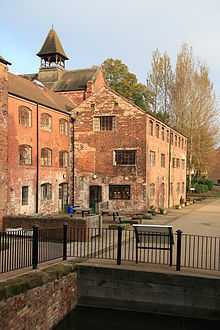Coalport porcelain

The Coalport porcelain manufactory (or Coalport China), the first porcelain factory in Coalbrookdale, Shropshire, England, was founded by the practical and enterprising John Rose in 1795,[1] at Coalport, served by the Coalport Canal, which had been completed in 1792. Rose had trained at the Caughley porcelain manufactory in Shropshire and had been making pottery on his own account nearby at Jackfield, a mile upstream across the River Severn from Coalbrookdale, since about 1780.[2] His rapid success enabled him to buy the Caughley manufactory in 1799,[3] the Nantgarw porcelain manufactory in 1819 and the Swansea porcelain manufactory, with their repertory of moulds.[4] He employed William Billingsley, formerly at Nantgarw, as chief painter, and Billingsley's chemist, Walker, who initiated at Coalport a maroon glaze and brought the Nantgarw technical recipes to Rose at Coalport.
In 1820 Rose received the gold medal of the Society of Arts for his feldspar porcelain and an improved, lead-free glaze, with which the enamel colours fused in firing.[5] Favourite patterns were the "worm sprig" and the "Tournai sprig" introduced by Billingsley at Pinxton, the Dresden-inspired "Berlin china edge", and the blue transfer willow pattern and blue dragon pattern.[6]
During the 1830s the factory initiated the practice of applying a light transfer printed blue outline, to guide the painters. This preserved some of the freedom of hand-painted decoration, while it enabled Rose to keep up the pace of production.[7] The technique was widely adopted by other manufactories during the 19th century.
John Rose died in 1841; the enterprise was continued under the former name "John Rose & Co." by his nephew W.F. Rose and William Pugh.
At The Great Exhibition (London 1851) an elaborate Coalport table service with deep borders of mazarin blue was shown; it had been commissioned by Queen Victoria as a gift to Tsar Nicholas I of Russia.[8]
William Pugh continued the production as sole proprietor from 1862 until his death in 1875, after which the company was put in receivership by his heirs. It was then reinstated by the Coalport China Company,[9] by whom an extensive export trade to the United States and Canada was initiated in the 1890s.
Llewellynn Jewitt published a History of the Coalport Porcelain Works in 1862. The standard modern monographic history is Geoffrey A. Godden, Coalport and Coalbrookdale Porcelain (London 1970).
The original manufactory building is now a Youth Hostel, cafe, artists' studios and a handmade arts & crafts shop.[10] Production later moved across the canal to the buildings which now house the Coalport China Museum. In 1926 production moved to Staffordshire, the traditional centre of the ceramics industry in Britain, and, although the Coalport name was retained as a brand, in 1967[11] the company became part of the Wedgwood group.
Specialties
Coalbrook and Coalbrookdale specialised in dinner services. The familiar "Indian tree" pattern, which is based in fact on Chinese rather than Indian prototypes, was originated at Coalport;[12] variants have been produced by virtually all the British manufacturers of table wares and continue to be available today. Models that originated at Meissen and Sèvres were copied at Coalbrookdale in the mid-19th century, sometimes with misleading marks,[13] "a practice which ought to have been avoided", William Chaffers observed.[14] Sprigged floral encrusted decoration was also typical of Coalbrook wares, such as vases, small boxes and table baskets.[15]
References
- ↑ Financial support was provided by Edward Blakeway (1720-1811); Rose's brother Thomas operated a small works at the former pottery of William Reynolds, operating 1800-1814, when they were traken over by J. Rose & Co. (Grove Encyclopedia of Decorative Arts, s.v. "Coalport Porcelain Factory"; for Rose's entrepreneurial spirit, see William Burton, A General History of Porcelain, 1921, vol. 2:102ff.
- ↑ Burton 1921.
- ↑ The Caughley works were consolidated at Coalbrook in 1814 (William Chaffers Marks and monograms on pottery and porcelain: with historical notices..., 2nd ed. 1866)
- ↑ A sketch of the factory's history, with marks including the Coalport monogram C (Coalport) and S (Salop) enclosing C, N and S for the three former factories, are in Chaffers 1866:356ff.
- ↑ Chaffers 1866; Burton 1921:106; Edward Dillon, Porcelain.
- ↑ All noted by Chaffers.
- ↑ Fleming and Honour 1977.
- ↑ A sample plate is conserved in the Victoria & Albert Museum, London.
- ↑ Burton 1921:105.
- ↑ An illustrated history of the buildings is presented by R.S. Edmundson, "Coalport China Works, Shropshire: A Comparative Study of the Premises and the Background to their Development" Industrial Archaeology Review 3.2 (Spring 1979) 122-145.
- ↑ The Potteries: Coalport Porcelain Works: sample of backstamps
- ↑ John Fleming and Hugh Honour, Dictionary of the Decorative Arts, 1977, s.v. "Coalport and Coalbrookdale porcelain factory".
- ↑ Fleming and Honour 1977.
- ↑ Chaffers 1866:357; Dillon, Porcelain 1904:366, notes in particular the rose Pompadour and turquoise grounds of "the pseudo-Sèvres porcelain that found its way to the London china-shops".
- ↑ Gordon H. Bushnell, The Illustrated Guide to 19th Century Coalport Coalbrookdale Floral Encrusted Porcelain, 2006.